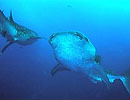 Despite its enormous size, whale sharks are completely harmless to humans.
Despite its enormous size, whale sharks are completely harmless to humans.Revealing the mystery of the world's largest fish
 Despite its enormous size, whale sharks are completely harmless to humans.
Despite its enormous size, whale sharks are completely harmless to humans.High-tech electronic cards mounted on whale sharks - the world's largest fish - have revealed their journeys and feeding grounds.
Researchers in Belize (an independent Commonwealth country, in Central America, the Caribbean Sea) tracked these sharks as they dived almost 1 kilometer to feed, and Find traces of fish that are laying to eat eggs.
"Our research shows that this shark dives much deeper than previously predicted, to depths of more than 1,000 meters to find food," Rachel Graham, of the US-based Wildlife Conservation Association. said."At this depth, the temperature of the water is only a few degrees above the freezing point, and it explains why the tropical whale has an independent fat layer just below the skin - which confuses scientists. for many years ".
At night, whale sharks often wander in shallow waters, eat ephemeral and store deep dives to retain heat for the day.These deep dives often end with rushing to the surface at high speed, perhaps to catch the flow of oxygen into the body after a period of time in deep oxygen deficient water.
Around the time of the full moon, Cubera snapper usually gathers near the coast to lay eggs, forming large tufts of bodies writhing in a "soup area" made of fish eggs.With whale sharks, this was a banquet, and they swam around, going through the soup over and over again, filling their huge mouth with goldfish bun.
Whale sharks are up to 20 meters long, and are listed as endangered sensitive species.Researchers believe that a recent discovery of their feeding ways and locations will help humans map out the tourist activities around whale sharks without harming them.Belize is the second largest coral reef system in the world and a natural heritage site recognized by UNESCO.
- Discovering many cosmic mysteries, people yearn to find new worlds
- Things you do not know about marine fish statues
- Uncover the mystery of strange fish: Whenever you eat, it is as drunk as drinking alcohol
- These fish hold record in nature
- Discover the skull of Britain's largest dog species
- The mystery behind the ability to discharge many fish
- The largest animals are extinct
- Top 6 largest fish in the ocean
- Discovered a new giant moonfish, weighing up to 2 tons
- Decipher mystery: Is it true that cats like to eat fish?
- The mystery of giant sturgeon, weighs a ton
- Mekong River fish ranked
 Surprised: Fish that live in the dark ocean still see colors
Surprised: Fish that live in the dark ocean still see colors Japan suddenly caught the creature that caused the earthquake in the legend
Japan suddenly caught the creature that caused the earthquake in the legend A series of gray whale carcasses washed ashore on California's coast
A series of gray whale carcasses washed ashore on California's coast Compare the size of shark species in the world
Compare the size of shark species in the world